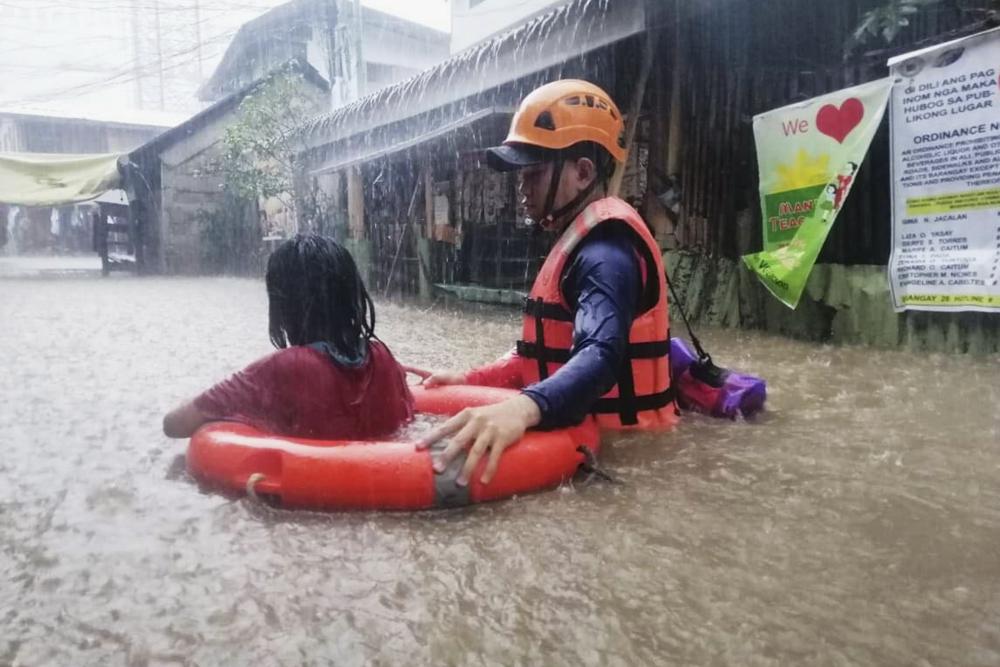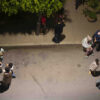In this handout photo provided by the Philippine Coast Guard, a rescuer assists a girl as they wade through flooding caused by Typhoon Rai in Cagayan de Oro City, southern Philippines on Thursday, Dec. 16, 2021. Tens of thousands of people were being evacuated to safety in the southern and central Philippines as Typhoon Rai approached Thursday at a time when authorities were warning the public to avoid crowds after the first infections caused by the omicron strain of the coronavirus were reported in the country, officials said. (Philippine Coast Guard via AP)
MANILA, Philippines (AP) — A powerful typhoon slammed into the southeastern Philippines on Thursday and was blowing across island provinces where nearly 100,000 people have been evacuated from high-risk areas that could be devastated by flash floods, landslides and tidal surges, officials said.
Forecasters said Typhoon Rai, which had sustained winds of 185 kilometers (115 miles) per hour and gusts of up to 230 kph (143 mph), blew from the Pacific Ocean into the Siargao Islands. There were no immediate reports of casualties or major damage but military and coast guard rescue personnel were helping residents stranded by fast-rising waters.
Disaster-response officials said about 10,000 villages lie in the projected path of the typhoon, which has a 400-kilometer (248-mile)-wide rain band and is one of the strongest to hit the country this year.
The Philippine coast guard said it has grounded all vessels, stranding nearly 4,000 passengers and ferry and cargo ship workers in dozens of southern and central ports. Several mostly domestic flights have been canceled and schools and workplaces were shut in the most vulnerable areas.
More than 98,000 people have been evacuated to safety, the government’s disaster-response agency said. Crowding in evacuation centers was complicating efforts to keep people safely distanced after authorities detected the country’s first infections caused by the omicron variant of the coronavirus. Intensified vaccinations were also halted in provinces likely to experience stormy weather.
The Philippines is among the hardest-hit in Southeast Asia by the pandemic, with confirmed infections of more than 2.8 million and more than 50,000 deaths. Quarantine restrictions have been eased and more businesses have been allowed to reopen in recent weeks after an intensified vaccination campaign helped reduce infections to a few hundred from more than 26,000 in September. The detection of the omicron cases this week, however, has set off the alarm and the government renewed calls for people to avoid crowds and get vaccinated immediately.
Gov. Ben Evardone of Eastern Samar province said he suspended vaccinations in his region of nearly half a million people due to the typhoon. More than 70% of villagers in the province have gotten at least one shot, and Evardone expressed concern because some vaccines stored in Eastern Samar will expire in a few months.
Overcrowding is unavoidable, he said, in the limited number of evacuation centers in his province, where more than 32,000 people have been moved to safety.
“It’s impossible to observe social distancing, it will really be tough,” Evardone told The Associated Press. “What we do is we cluster evacuees by families. We don’t mix different people in the same place as a precaution.”
About 20 storms and typhoons batter the Philippines each year. The archipelago is also located in the seismically active Pacific “Ring of Fire” region, making it one of the most disaster-prone countries in the world.
Copyright 2021 Associated Press. All rights reserved.








































